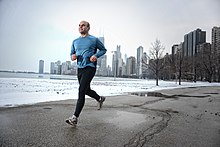Running
Running is the way in which people or animals travel quickly on their feet. It is a method of travelling on land. It is different to walking in that both feet are regularly off the ground at the same time.[1] Different terms are used to refer to running according to the speed: jogging is slow, and sprinting is running fast.





Running is a popular form of exercise. It is also one of the oldest forms of sport. The exercise is known to be good for health; it helps breathing and heartbeat, and burns any spare calories. Running keeps a person fit and active. It also relieves stress. Running makes a person thirsty, so it is important to drink water when running.
Benefits of running
change- Fitness – From wanting to lose weight to trying to fight disease and aging, there are lots of health benefits to running.[2]
- Mental health – Whether to help depression or find some time to think, there are large mental benefits to running as well.[3][4]
- Running is also fun and does not need special equipment to do it. When running, the muscles, lungs, brain, heart and other organs get better.
- Running is often used as cross-training for many sports, especially ones that require sustained endurance.
Ways to avoid injuries
changeRunning injuries are quite common among runners. Many running injuries can be reduced through proper training, wearing of the correct gear and awareness of the running environment.
Physical
change- Before going on a long run, do not forget to have a five-minute warm-up and some stretching exercises.
- After going on a long run, do not forget to have ten-minutes of cool-down with some stretching exercises.
- In the short term, try running on a flat surface. In the long term coaches recommend cross-country running.
- Running in a way to reduce loading on legs. One method is to use a treadmill, the better is to run in minimal shoes. These allow the runner's feet to feel the ground and so not inadvertently overload the foot/ankle. Over-cushioned shoes prevent the foot from feeling what it is doing and can also damage ones shins and knees. This topic has been very controversial. There are countless coaches, runners, and scientists who argue that minimal shoes are a main culprit in injuries in runners. They highly recommend shoes that offer stability and cushioning. Many runners with injuries have found that switching to cushioned shoes has improved/cured them of their injuries.
Environmental
change- In hot climates, it is better to run in the morning. This will help to reduce fatigue and heat stress.
- Do not run when pollution levels are high.
- Run in the shade if possible, wear sunglasses, apply sunscreen and try to avoid direct sun rays.
- Too much clothing can produce sweating, which causes the body to lose heat quickly. Dress in layers. Wear the correct footwear.
- When running in cold weather wear hat, gloves and clothing that covers your neck.
Racing
changeRunning is a part of many forms of competitive racing. Most running races test speed, endurance or both. Track and field races are usually divided into sprints, middle-distance races and long-distance races. Races held off the track may be called cross-country races. A marathon is run over 42 kilometres.
Footraces have probably existed for most of human history. They were an important part of the ancient Olympic Games.
References
change- ↑ Biewener, A. A. (2003) "Animal Locomotion" Oxford University Press, USA. ISBN 978-0-19-850022-3
- ↑ Rob Stein (29 January 2008). "Exercise Could Slow Aging Of Body, Study Suggests". The Washington Post.
- ↑ Gretchen Reynolds (4 November 2009). "Phys Ed: Why Doesn't Exercise Lead to Weight Loss?". The New York Times.
- ↑ Barton, J.; Pretty, J. (2010). "What is the Best Dose of Nature and Green Exercise for Improving Mental Health? A Multi-Study Analysis". Environmental Science & Technology. 44 (10): 3947–3955. Bibcode:2010EnST...44.3947B. doi:10.1021/es903183r. PMID 20337470. S2CID 1443095.
{{cite journal}}: CS1 maint: multiple names: authors list (link)
Other websites
changeMedia related to Running at Wikimedia Commons
- Running at the Open Directory Project